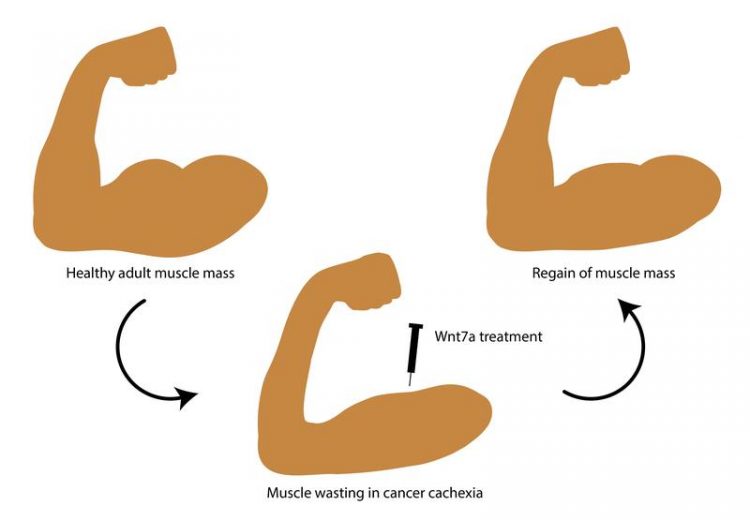Cancer cachexia: Extracellular ligand helps to prevent muscle loss

Wnt7a has a dual function in cachectic skeletal muscle: it counteracts muscle wasting and reverts the loss of muscle stem cell functionality. Source: Magdalena Voll / FLI
Cancer Cachexia often occurs in cancer patients in an advanced state. This metabolic wasting syndrome leads to severely reduced muscle mass and fat tissue, which cannot be reversed by nutritional support. Furthermore, muscle regeneration is affected during cancer cachexia due to impaired muscle stem cell function.
A problem that also occurs often in the aging process. Cancer cachexia is associated with a poor prognosis for patients, since it weakens patients towards a point that no further therapy, such as chemotherapy or surgery can be tolerated. So far, this multifactorial syndrome has not been fully understood and effective therapies are still lacking.
The research group “Stem Cells of Skeletal Muscle” lead by Dr. Julia von Maltzahn at the Leibniz Institute on Aging – Fritz Lipmann Institute (FLI) in Jena, Germany, investigated the extracellular ligand Wnt7a and was able to show its positive influence on muscle mass and muscle stem cells in cancer cachexia independently of the tumor cell type causing cachexia.
Wnt7a has already been in focus in muscular dystrophy studies: “It was already known, that Wnt7a ameliorates muscular dystrophy”, explains Dr. Julia von Maltzahn, junior group leader at the FLI. “We were interested if similar positive effects also occur in cancer cachexia.” The results of their studies have now been published in the open access journal Molecular Therapy: Oncolytics.
Influence of Wnt7a on muscle mass
The research group was able to show in human skeletal muscle cell lines and in a mouse model that Wnt7a treatment counteracted muscle wasting and improved muscle stem cell differentiation – two major symptoms of cachexia in cancer patients. The extracellular ligand Wnt7a activates the anabolic AKT/mTOR pathway in myofibers and reverts the loss of muscle stem cell functionality.
“Our results show that Wnt7a has a dual function in skeletal muscle: it activates an important signaling pathway enhancing muscle mass and drives muscle stem cell expansion in skeletal muscle, which is necessary for regeneration”, says Dr. Manuel Schmidt, postdoc in the research group. This makes Wnt7a a promising candidate for the treatment of muscle wasting diseases also in humans, since the protein has the same function in mice and men.
Wnt7a is able to prevent muscle loss in cancer cachexia making it a potential candidate to be used during treatment or surgeries. In addition, the extracellular ligand could be used as a supportive treatment during therapy/surgery. Wnt7a leads to an increase in the stem cell population in the muscle, which supports muscle regeneration after surgery. Following these research results, the researchers are now testing further possible applications.
Publication
Schmidt M, Poser C, von Maltzahn J, Wnt7a counteracts cancer cachexia, Molecular Therapy: Oncolytics (2020), doi: https://doi.org/10.1016/j.omto.2019.12.011.
Contact
Magdalena Voll
Press and Public Relations
Phone: 03641 656378, email: presse@leibniz-fli.de
Background information
The Leibniz Institute on Aging – Fritz Lipmann Institute (FLI) – upon its inauguration in 2004 – was the first German research organization dedicated to research on the process of aging. More than 350 employees from around 40 nations explore the molecular mechanisms underlying aging processes and age-associated diseases. For more information, please visit https://www.leibniz-fli.de/.
The Leibniz Association connects 96 independent research institutions that range in focus from the natural, engineering and environmental sciences via economics, spatial and social sciences to the humanities. Leibniz Institutes address issues of social, economic and ecological relevance. They conduct knowledge-driven and applied basic research, maintain scientific infrastructure and provide research-based services. The Leibniz Association identifies focus areas for knowledge transfer to policy-makers, academia, business and the public. Leibniz Institutes collaborate intensively with universities – in the form of “WissenschaftsCampi” (thematic partnerships between university and non-university research institutes), for example – as well as with industry and other partners at home and abroad. They are subject to an independent evaluation procedure that is unparalleled in its transparency. Due to the institutes’ importance for the country as a whole they are funded jointly by the Federation and the Länder, employing some 20,000 individuals, nearly half of whom are researchers. The entire budget of all the institutes is approximately 2.1 billion EUR. See https://www.leibniz-gemeinschaft.de/en.html for more information.
Schmidt M, Poser C, von Maltzahn J, Wnt7a counteracts cancer cachexia, Molecular Therapy: Oncolytics (2020), doi: https://doi.org/10.1016/j.omto.2019.12.011
Media Contact
All latest news from the category: Life Sciences and Chemistry
Articles and reports from the Life Sciences and chemistry area deal with applied and basic research into modern biology, chemistry and human medicine.
Valuable information can be found on a range of life sciences fields including bacteriology, biochemistry, bionics, bioinformatics, biophysics, biotechnology, genetics, geobotany, human biology, marine biology, microbiology, molecular biology, cellular biology, zoology, bioinorganic chemistry, microchemistry and environmental chemistry.
Newest articles

Properties of new materials for microchips
… can now be measured well. Reseachers of Delft University of Technology demonstrated measuring performance properties of ultrathin silicon membranes. Making ever smaller and more powerful chips requires new ultrathin…

Floating solar’s potential
… to support sustainable development by addressing climate, water, and energy goals holistically. A new study published this week in Nature Energy raises the potential for floating solar photovoltaics (FPV)…

Skyrmions move at record speeds
… a step towards the computing of the future. An international research team led by scientists from the CNRS1 has discovered that the magnetic nanobubbles2 known as skyrmions can be…





















